Choosing the right programming language is one of the first steps towards building successful software. The language you choose influences all development processes, further product maintenance, and support. The problem is that it’s always challenging to pick the most suitable language for a project, as no programming language can be defined as superior in all aspects.
In this article, we describe the most important factors you need to consider when choosing a programming language. We also explore the specifics and differences between C, C#, and Python in detail and compare the performance of a simple program written in each of these three languages.
This article will be useful for developers who want to learn more about how to choose a programming language for a project.
Contents:
What to consider when choosing a programming language
The devil is in the details, and you have to consider multiple aspects of your future software to pick the most suitable technology stack. Make sure to analyze the product type, software scalability, complexity, budget, timeline, security, available resources, and so on.
Only after that can you evaluate how different languages can fulfill the requirements for a future product.
Let’s discuss the key software specifics in detail:
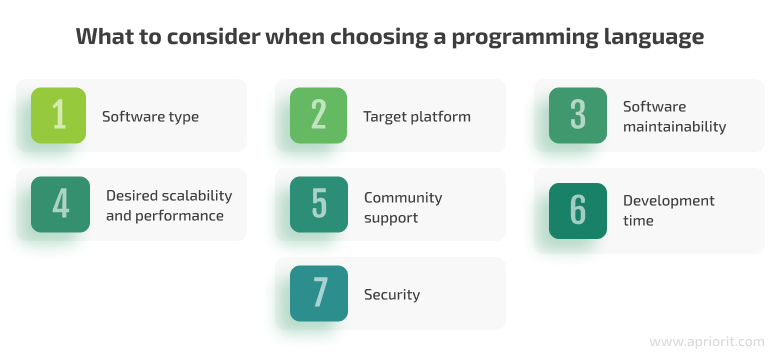
1. Software type. Clearly define the product’s type, goals, and tasks. These factors will provide developers with a better understanding of the product’s complexity, size, and other nuances. Thus, they can choose the most suitable language (or even several) that will help you build a reliable project.
For example, object-oriented languages such as C# and Python are best suited for web applications. For Android applications, it’s reasonable to choose Java or Kotlin. And for systems programming, consider using mid-level languages like C. Some languages such as C and Assembly are not a good choice for mobile and web development, and it’s best not to use Python or Ruby for driver development.
2. Target platform. Keep in mind the target platform where you plan to run your solution, as each platform supports a certain set of languages. Say you decide to use two languages: Java and C. If you’ve written a program in C and want to run it on Windows and Linux, you’ll need to use platform compilers and two different executables. When working with Java, you need to install the Java Virtual Machine to run the generated bytecode.
For web applications, you have to make sure they look and work the same across different browsers. You might fail to ensure this if you use, for example, CSS3 and HTML5 tags.
3. Software maintainability. When choosing a programming language for your project, think ahead about simplifying your software maintenance and ensuring your software’s long-term survivability. Regardless of the technologies and languages you use, you always have an ecosystem of libraries and third-party solutions you need to support. And to properly maintain your product, it’s essential not only to choose the latest release of all technologies in the stack but also to plan activities to keep everything up to date.
4. Desired scalability and performance. Different programming languages offer different opportunities for both the performance and scalability of your software. Here are a few questions about an IT product that you need to consider when choosing a programming language:
- How many users will your software serve?
- Would growth in the number of users slow down the performance of your application or break it?
- How fast can you scale your solution if the number of users significantly increases?
- Is your solution flexible enough to accept additional functionality without compromising performance?
Performance requirements can also restrict your choice of programming language for the project. For example, scripting languages such as Python and Ruby can be much less efficient than traditional compiled languages.
5. Community support. Whatever solution you’re working on, there’s always a chance of getting stuck with a complex or non-trivial programming problem. And if there’s not enough community support around a certain technology or programming language, overcoming such issues on your own can be extremely challenging and time-consuming.
Python, for example, has a huge community, and you can find lots of materials, guides, and how-to content for Python development on the internet. For C and C#, you can also find specialized forums, enthusiast communities, and helpful resources.
6. Development time. Choosing a programming language with a lot of libraries, packages, and modules relevant to your project will help the development team spend less time on coding. Instead of writing certain functionalities themselves, they can use third-party components and thus accelerate the development process.
For example, in Python, it often takes fewer lines of code to write a program compared to what it would take in other languages. Also, there are lots of special Python wrappers for third-party products’ APIs that you can use to integrate your software with third-party libraries, databases, and other IT products. Developing a solution in C, on the contrary, might be more time-consuming because of the code volume.
7. Security. A developer’s mistake using a certain programming language can lead to security issues with your solution and even impact the work of the operating system. And it’s easier to make mistakes in some programming languages than in others. For example, when coding in C, developers have to work with lots of low-level details and interact with operating systems. If they make a mistake during such activities, it can cause vulnerabilities in the final product.
Python and C# are considered safer programming languages because they offer professionally developed and thoroughly tested libraries. By using these libraries for building software, developers significantly minimize the possibility of making mistakes that lead to security vulnerabilities in the future.
Once you establish software requirements for the specifics mentioned above, it will be easier to choose a language.
With hundreds of existing programming languages, it would be challenging to compare all of them in one text. So in this article, we focus on three popular ones: C, C#, and Python.
Python: Pros, cons, and where to use it
Python is a scripting language, which means that program code is defined in the form of scripts. To work with scripts, you need an interpreter that launches and executes them.
This language is suitable for solving many tasks across different platforms while offering portability and platform independence. Regardless of what operating system you use, you only need to write a script once and use an interpreter to run it on different operating systems.
Python supports a variety of programming paradigms, including object-oriented and functional. It also offers automatic memory management, so the developer doesn’t have to manually allocate memory before it can be used by a program and release it when the program no longer needs it.
Here’s a brief explanation of how Python programs are executed:
- A developer writes a script in a text editor with a set of expressions in a given programming language.
- The script is passed to the interpreter for execution.
- The interpreter translates the code into intermediate bytecode.
- The virtual machine translates the resulting bytecode into a set of instructions that are executed by the operating system.
Formally, the translation of source code into bytecode by an interpreter and the translation of bytecode by a virtual machine into a set of machine instructions are two different processes. However, in Python, they are combined in the interpreter:
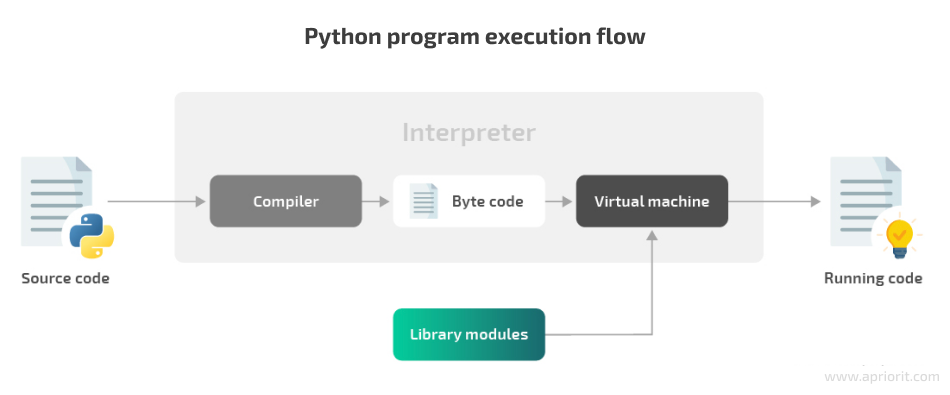
Python has gained its popularity thanks to a range of advantages, including:
- Fast development speed. It takes many fewer lines of code to write a program in Python than in other popular languages like Java and C. Thus, you can deliver the final solution quite fast.
- Variety of libraries. In addition to the Python Standard Library, a large selection of additional libraries can enhance your software development process. Here are a few popular examples:
- Scalability. You can easily scale programs and applications written in Python due to the ability to adapt their high-level logic.
- Versatility. Python is an interpreted language that is used for coding on almost all modern platforms. It doesn’t need to be compiled, and its code can be written in a regular text document.
- Global community. One of the important factors in the rapid popularization of Python is the large community of developers and enthusiasts. The language functions and evolves thanks to regularly updated and well-regulated Python Enhancement Proposals.
However, Python also has some downsides. The two most critical issues are related to performance and memory consumption:
- Performance limitations. Python isn’t a good choice for developing high-performing projects, and it’s usually combined with other languages. The reason is that Python has outdated Global Interpreter Lock code that has not changed since the very first version of the language. Therefore, software written in Python might not work as fast as software written in some other languages.
- High memory consumption. On the one hand, dynamic typing allows for more flexibility in programming. In Python, the same variable can have a different type at different times during execution. But on the other hand, because of dynamic typing, Python is a rather resource-intensive programming language and consumes a lot of memory.
The versatility, simplicity, and high speed of writing Python code allows it to be used in various areas, including the following:
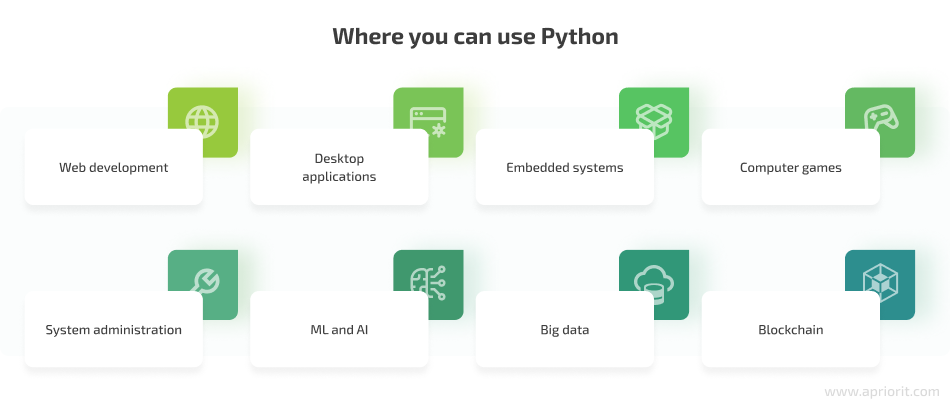
- Web development. One of the most popular uses for Python is in developing web applications, as Python offers lots of helpful frameworks including Django, Flask, Pyramid, and CherryPy. There are also some Python-driven engines for web applications such as Django-CMS, Abilian SBE, and Saleor, as well as software for parsing data on the internet.
- Desktop applications. Although Python is an interpreted language, it’s suitable for developing PC programs. Examples of popular Python software include the GIMP visual editor, Ubuntu Software Center, and the well-known BitTorrent client (up to version 6).
- Embedded systems. Although C and C++ dominate in embedded solutions, there’s also software developed in Python. It’s used in Raspberry Pi minicomputers, ATMs, telecom equipment, CNC machines, and many other types of devices. The reason lies in such Python benefits as writability, error reduction, and readability.
- Computer games. Python is often used to script scenes, events, and characters in PC games. For example, it was used to create such popular games as EVE Online, Battlefield, and Civilization.
- System administration. Python provides system administrators with tools for automating infrastructure orchestration and executing various tasks. For example, popular automation tools like Saltstack and Ansible are written in Python. The simplicity and consistency of its syntax allows you to quickly find errors in the code. Python is also the standard programming language for all Linux servers.
- Machine learning (ML) and artificial intelligence (AI). ML and AI are among the most popular and promising use cases for Python. This language offers numerous libraries for ML and AI development including TensorFlow and Scikit-Learn. They are designed to train neural networks, control industrial systems, and perform other tasks.
- Big data. Developers actively use Python to work with big data, particularly to analyze and visualize it and to predict trends. A few examples of special libraries for computing and processing big data are SciPy, Matplotlib, and Pandas.
- Blockchain. Python is especially convenient for blockchain development because you can use it to easily perform many tasks with a single command. Thus, you can easily build blocks with relevant information and link them together. Also, developers don’t have to worry about using curly brackets or keywords, as there are no white spaces denoting code blocks.
The C language: Benefits and challenges
The C programming language was formed in the early 1970s but is still actively used today to write parts of the program code for Unix-like operating systems, utilities, and compilers. Developers often call C the system programming language.
The long life of this language can be explained by the fact that the principles of operating system work are relatively universal. Operating systems are not as frequently updated as desktop, mobile, and web applications. C is considered one of the most powerful programming languages because it allows for direct access to memory and many low-level computer operations.
Compiling C source code is a multi-step process involving preprocessing, code compilation, library linking, etc. Here’s a simple scheme of how the C compilation process works:
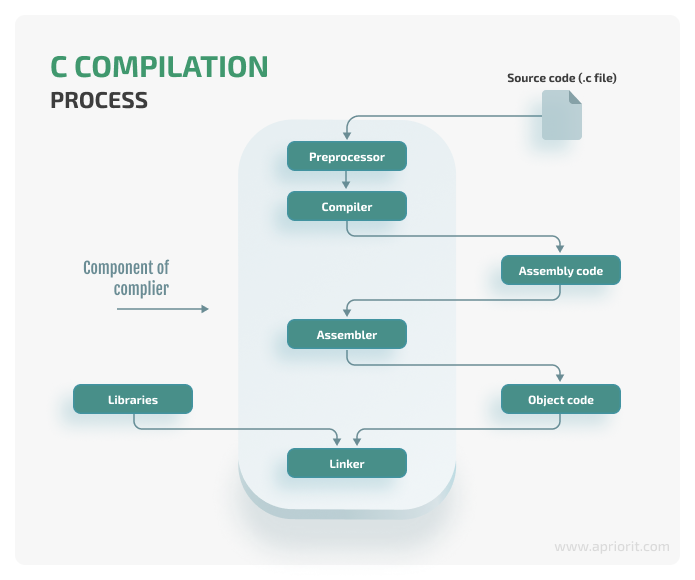
Let’s examine the key advantages and disadvantages of programming with C, starting with its key benefits:
- Easy to comprehend. One of the primary reasons that people prefer C over other programming languages is the language’s simplicity. As a result of the limited number of keywords and symbols used in C, developers can quickly grasp the fundamental concepts.
- Powerful and efficient language. Because of C’s efficiency, it’s easy to write efficient code, which in turn results in improved runtime performance.
- Supports key platforms. C is compatible with a wide range of operating systems and platforms including Windows, Linux, macOS, Android, and iOS.
- Rich in library functions. The C programming language includes a large number of built-in functions that are divided into two categories: system-generated and user-defined.
The downsides of coding with C include the following:
- No object-oriented programming (OOP). C doesn’t support OOP concepts (inheritance, polymorphism, encapsulation, abstraction, and data hiding) that are commonly used in other programming languages.
- No support for exception handling. Exception handling helps you identify and respond to errors in a timely and appropriate manner. C doesn’t have this critical characteristic.
- Low level of abstraction. C is a small and fundamental machine language that has limited capabilities for data hiding and great visibility, both of which have an impact on its security.
- No garbage collection. There’s no garbage collection in C. Developers have to manage storage, which can slow down and complicate the development process.
Despite its downsides, you can use C to build products across various areas, including the following:

- Operating systems. The most famous use case for C is developing operating systems, where this language is usually combined with several others. For example, the kernel layer and hardware device drivers of macOS are written in the C programming language.
- 3D movies. Creators of 3D videos often prefer the C language because it helps with handling a large quantity of data and allows an application to perform lots of computations per second.
- Embedded software. Since developing embedded systems is related to machine hardware, C is often the best choice for scripting programs and drivers for embedded systems.
C#: Advantages, disadvantages, and use cases
C# is a programming language that combines object-oriented and context-oriented concepts. It belongs to a family of languages with a C-like syntax and is closest to C++ and Java. C# was developed as the main application development language for the Microsoft .NET platform.
The C# compiler is included in the standard installation of .NET, so you can create programs in it without even using tools like Microsoft Visual Studio. .NET language compilers translate source code into Microsoft Intermediate Language (MSIL). This ensures language interoperability because no matter which language you use to develop software, it can be translated to MSIL.
Before program execution, the Just In Time (JIT) compiler compiles MSIL code into native code and stores it in a memory buffer. The JIT compiler helps to improve the performance of C# programs by compiling bytecode into native machine code at run time, which is more efficient than simply interpreting the code as it is.
After translating the intermediate language (IL) into native code, it’s sent to the .NET runtime manager. The .NET runtime manager executes the code. During execution, managed code receives services such as garbage collection, security, interoperability with unmanaged code, cross-language debugging support, and enhanced deployment and versioning support.
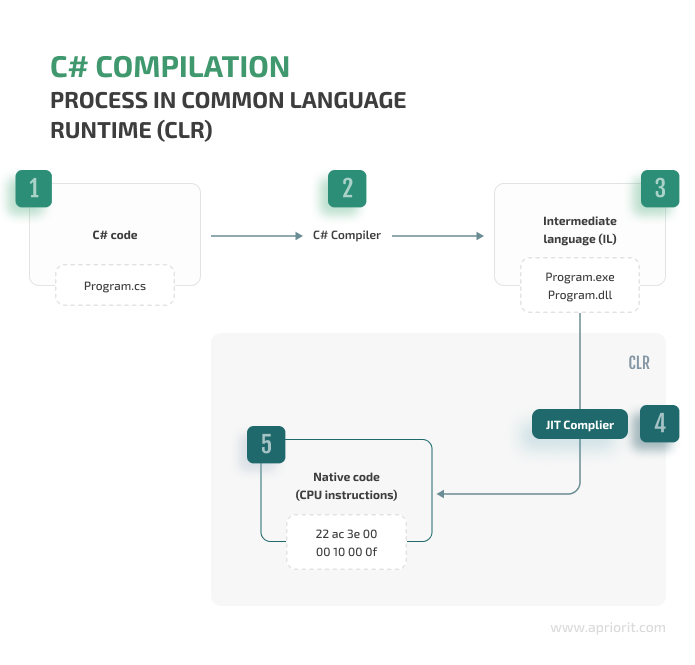
If you consider building your infrastructure in C#, make sure to explore both the pros and cons of this language before you start.
The C# language has strong static typing and supports polymorphism, operator overloading, pointers to member functions of classes, attributes, events, and other features. Unlike its predecessors, C# excludes some models that have proven to be problematic in the development of software systems. For example, C# does not support multiple inheritance of classes (like in C++) or type inference (like in Haskell).
The most important advantages of C# are:
- Microsoft support. Developers can efficiently overcome various issues and learn more about C# capabilities thanks to Microsoft guides and other helpful documentation.
- Active improvement. Since C# was created later than Java and other languages, its creators put lots of effort into making the coding experience with C# more convenient and efficient. Also, helpful tools like Visual Studio and Xamarin are free for individuals and small companies.
- Lots of syntactic sugar. Syntactic sugar refers to constructs that are created to make code easier to write and understand, especially when it comes to someone else’s code. C# offers syntactic sugar for common operations that are usually expressed in a more verbose form.
Some of the disadvantages of C# are:
- Focus on .NET. C# heavily relies on .NET resources to run on different operating systems or platforms. It’s not flexible on its own, so you shouldn’t choose C# if you’re not considering .NET as your main technology stack.
- Price. Microsoft tools for the C# language are free only for small companies, students, and individual programmers. For large teams, licenses can be expensive.
- Development limitations. A programmer cannot do low-level things like interact directly with hardware through drivers and firmware.
- Steep learning curve. C# is not easy to learn, and numerous .NET libraries which are continuously updated add another layer of complexity. C# developers also have to work with multiple runtimes when building cross-platform applications.
The C# language is often preferred for backend programming and automation in Windows environments. But you can use it to build different types of programs and applications. The four fields where this language is exceptionally versatile are:

- Web application development. Regardless of the platform, you can still use the C# programming language to build dynamic websites and web apps using the .NET platform or other open-source platforms.
- Windows applications. Microsoft created C# for their products. It makes your Windows software development process smooth and ensures exceptional performance of functionalities like C# garbage collection. Programmers can also count on community support and documentation for Windows-specific development.
- Games. Game developers use game engines like Unity to build video games. Unity is a trusted platform that has more than a billion active users and allows you to develop award-winning games and AR/VR experiences.
- Cross-platform enterprise applications. Business software usually must connect to several instances, move large amounts of data back and forth, and smoothly work with numerous programs, interfaces, databases, and third-party solutions. Many databases, APIs, and CRMs employ the C# programming language.
With basic information about all these languages in mind, let’s compare them to see how each of them handles the same task.
Comparing Python, C, and C# using a practical example
To compare the performance of each language, we’ll write a simple small program that counts the frequency of unique words in a text file on a disk and displays the ten most frequently used words by number of appearances. Thus, we’ll see the difference between Python, C, and C# in both development speed and performance.
Say you have a file with the following text: Cat language cat cat milk language.
A working program should print the following:
cat 3
language 2
milk 1Here’s what a basic solution should do:
- Read the file line by line
- Convert all characters to lowercase
- Split each line into words
- Count the frequency of each word in a hash table
- Convert the hash table to a list of word-count pairs
- Sort words by count (largest first)
- Print the 10 most frequently used words
For our solution, we’ll use War and Peace by Leo Tolstoy, which has more than 1,000 pages and more than 500,000 words. The file with the text is called “sample.txt.”
Writing a program in Python
The code for such a program written in Python looks like this:
counts = {}
with open("sample.txt") as input_file:
for line in input_file:
words = line.lower().split()
for word in words:
counts[word] = counts.get(word, 0) + 1
frequencies = sorted(counts.items(), key=lambda pair: pair[1], reverse=True)
for word, count in frequencies[:10]:
print(word, count)If we launch it like this in the python3 count_words.py terminal, we’ll get the following output:
the 34026
and 21323
to 16415
of 14785
a 10396
he 9351
in 8663
his 7932
that 7395
was 7202Let’s measure the execution time for this small program. As we’re launching our application on Ubuntu, we can use the multitime utility to show the average execution time for several launches of the same application.
After launching the application ten times, we see that the average time is about 0.256 seconds, which is quite good for such a large book.

But the biggest advantage Python shows is the program size, as it only takes nine non-blank lines of code to open the file, read it, and count each word. We can make it even shorter if we use the Python Standard Library and the collections module:
from collections import Counter
counts = Counter()
with open("sample.txt") as input_file:
for line in input_file:
counts.update(line.lower().split())
for word, count in counts.most_common(10):
print(word, count)
This application produces the same output, but the average execution time now is about 0.290 seconds with only seven non-blank lines:

Python allows you to write code quickly and has a rich standard library that is perfect for prototyping and writing scripts.
Writing a program in С
Let’s run a Python vs C comparison and write the same program in the C language. As C doesn’t have a built-in dictionary type, we use the hash tables implementation from search.h. The program looks like this:
#include <ctype.h>
#include <search.h>
#include <stdio.h>
#include <stdlib.h>
#include <string.h>
#define MAX_UNIQUES 60000
typedef struct {
char* word;
int count;
} count;
int cmp_count(const void* p1, const void* p2) {
int c1 = ((count*)p1)->count;
int c2 = ((count*)p2)->count;
if (c1 == c2) return 0;
if (c1 < c2) return 1;
return -1;
}
int main() {
count* words = calloc(MAX_UNIQUES, sizeof(count));
int num_words = 0;
if (hcreate(MAX_UNIQUES) == 0) {
return 1;
}
FILE *fptr = fopen("sample.txt","r");
char word[101];
while (fscanf(fptr, "%100s", word) != EOF) {
for (char* p = word; *p; p++) {
*p = tolower(*p);
}
ENTRY item = {word, NULL};
ENTRY* found = hsearch(item, FIND);
if (found != NULL) {
int* pn = (int*)found->data;
(*pn)++;
} else {
item.key = strdup(word);
if (item.key == NULL) {
return 1;
}
int* pn = malloc(sizeof(int));
if (pn == NULL) {
return 1;
}
*pn = 1;
item.data = pn;
ENTRY* entered = hsearch(item, ENTER);
if (entered == NULL) {
return 1;
}
words[num_words].word = item.key;
num_words++;
}
}
for (int i = 0; i < num_words; i++) {
ENTRY item = {words[i].word, NULL};
ENTRY* found = hsearch(item, FIND);
if (found == NULL) {
return 1;
}
words[i].count = *(int*)found->data;
}
qsort(&words[0], num_words, sizeof(count), cmp_count);
for (int i = 0; i < 10; i++) {
printf("%s %d\n", words[i].word, words[i].count);
}
return 0;
}Let’s build the program using gcc:
gcc count_words.c -O3 -o count_wordsAfter launching the program with the multitime utility, we see that it runs three times faster than the one built in Python while showing the same output. However, the program built in C has 69 non-blank lines.
The more lines it takes to write a program, the more resources a company spends. Also, large volumes of code can significantly complicate the understanding of this code for other developers on the team.

Also, the application written in C takes much less memory during execution. So if you want to write more efficient (but more verbose) code, C is the best choice.
Writing a program in С#
Now it’s time for the C# vs C comparison. The same program in C# is much smaller than in pure C but much more readable and similar to the Python one:
using System;
using System.IO;
using System.Collections.Generic;
using System.Linq;
class Program
{
static void Main(string[] args)
{
var counts = new Dictionary<string, int>();
foreach (string line in System.IO.File.ReadLines("sample.txt"))
{
var line_lower = line.ToLowerInvariant();
var words = line_lower.Split(' ', StringSplitOptions.RemoveEmptyEntries);
foreach (string word in words)
{
counts[word] = counts.GetValueOrDefault(word, 0) + 1;
}
}
var ordered = counts.OrderByDescending(pair => pair.Value).Take(10);
foreach (var entry in ordered)
{
Console.WriteLine("{0} {1}", entry.Key, entry.Value);
}
}
}If we compare C# vs Python, it takes a little more time to write code in C#, as the program consists of 30 non-blank lines. However, C# shows a little bit better performance than Python:

C# has all the benefits of static typing from C but also is much more readable.
Summary of languages comparison
Here are a few of the most important factors you should consider before choosing a language:
- If development speed and a large variety of libraries are crucial for your project (for example, if you’re creating a proof of concept or a web service), then Python might be the best choice for you.
- If performance is critical for your application or if you’re working on system programs or drives, then nothing will do the job better than C.
- If you plan to develop fast Windows-specific desktop software, then C# will be great for your needs.
To sum up the results of comparing Python, C, and C#, let’s take a look at a subjective rating table so you can visually evaluate each language in different categories:
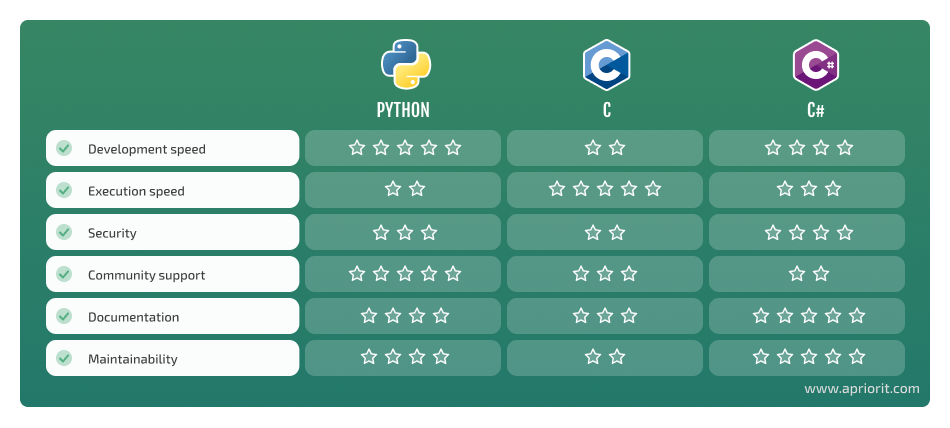
Conclusion
To choose the language that will fit your project best, you need to consider multiple factors and nuances of your future software. Unfortunately, listing all of them in one article and advising on the most suitable language for each scenario would be impossible. However, we hope that the language descriptions and comparison examples we have discussed will help you better understand the process of picking the technology stack for a project.
Contact us to choose the right programming language and start developing your dream project!
At Apriorit, we have professional development teams with experience building solutions for different industries in C, C#, and Python. Our experts will gladly assist you with choosing the most suitable technology stack for your project to ensure that your software helps you reach your business goals.


